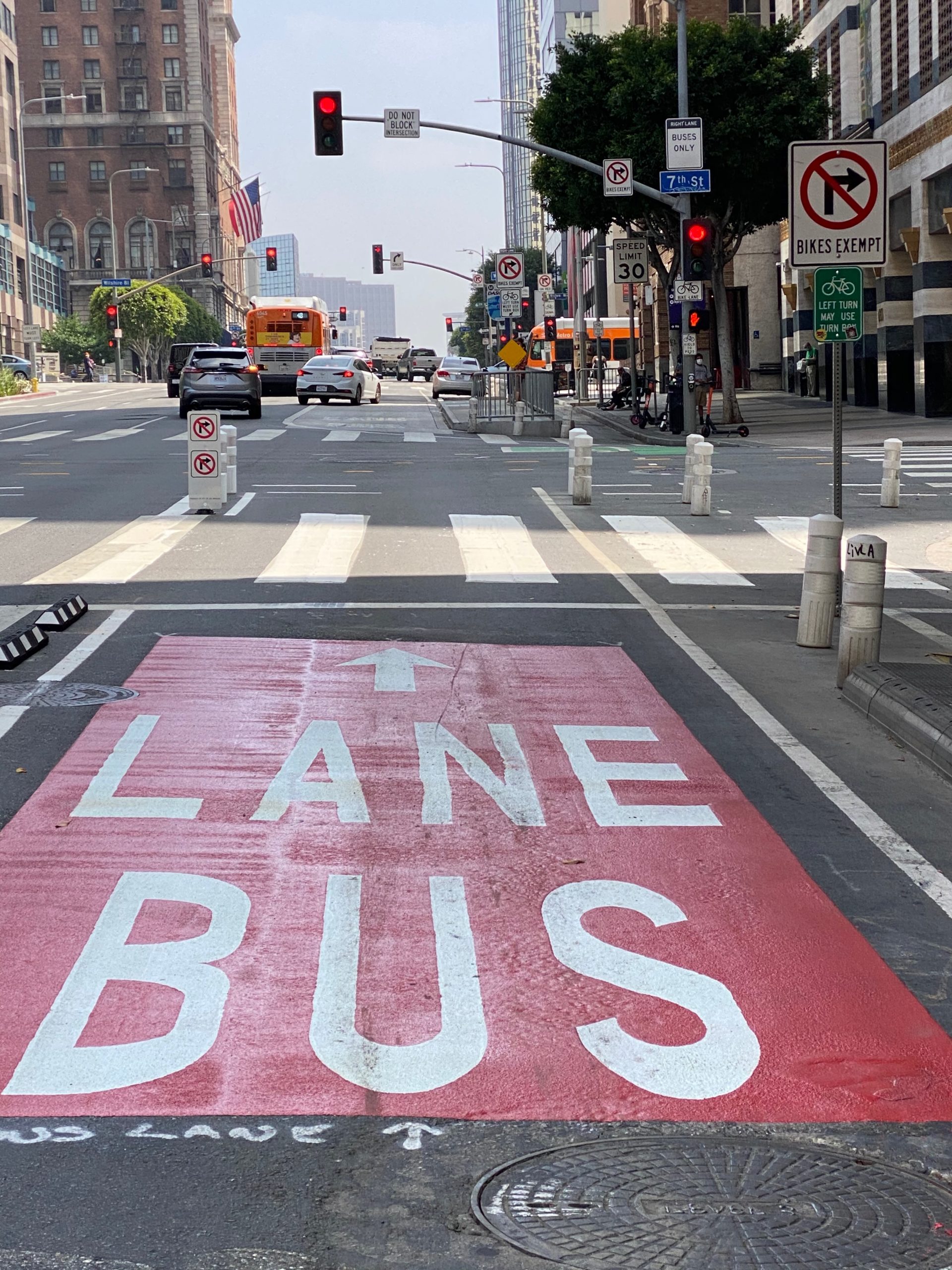Note: This blog was guest written by Jordan Fraade, a second-year master’s student in UCLA’s Urban Planning program. Jordan is completing his Applied Planning Research Project in coordination with Investing in Place.
Last month, I wrote my first blog post for Investing in Place, introducing my project on “how we can work together to push Los Angeles into a future when bus riders can count on the same high-quality, frequent service that rail riders receive on a regular basis.” In practice, this means investing in Bus Rapid Transit (BRT) — city planners’ catchall term for a variety of bus improvements that increase frequency and speed, decrease time buses spend waiting at stations, and ensure that buses don’t have to sit in traffic.
Back in 2013, Metro released a study identifying 9 potential BRT routes throughout the county, and two of them, Vermont Avenue and the North Hollywood-Pasadena connector, were given more funding when we passed Measure M in November. In early February, Metro released a Technical Study for the Vermont Avenue BRT, which provides 4 alternatives for what the line might look like.
Vermont is second busiest corridor in LA County. Need bus rapid transit (maybe light rail?). Connecting jobs/housing/play #metroplan
— Investing in Place (@InvestinPlace) April 23, 2016
The agency has a decision to make…How can we ensure that Metro makes the most of this exciting opportunity for Los Angeles’ bus riders?
Case Study: Bus Rapid Options for Vermont Avenue
The stakes are very high. Vermont Avenue is the second-most-travelled transit corridor in the city, second only to Wilshire, with an estimated 45,000 bus trips every weekday — for comparison, the entire Metrolink system serves more than 39,000 riders a day. The neighborhoods adjacent to the Vermont Avenue corridor are mostly low-income, densely populated, and have a high percentage of households that commute by transit. There is already frequent transit service on the 204 and 754 buses, but because the corridor is so congested, the buses are overcrowded and slow.
@ABC7Marc @Chris_Ledezma It’s a slow start because I’m stuck on this @metrolosangeles Rapid 754 bus stuck in traffic on Vermont/MLK haha
— Black Seth Rogen (@ChristianAllen1) October 9, 2015
Metro estimates that if BRT is implemented along Vermont, we could be looking at nearly 75,000 riders per day by 2035.

The study area for Vermont BRT is just over 12 miles, stretching from Hollywood Blvd. to 120th Street. Metro’s proposals include:
1. Side-running BRT for the entire corridor (12.4 miles). Currently, each side of Vermont Avenue features 2 or 3 travel lanes, plus a parking lane on the far right. This proposal would take the travel lane next to parking and convert it into an exclusive lane for buses.

2. Side-running BRT for the northern end of the corridor and center-running BRT for the southern end. South of Gage Avenue, where Vermont becomes wider, the exclusive bus lanes would be placed in the center of the road instead of along the side.

3. Converting the on-street parking lane into an exclusive bus lane. This would remove more than half the on-street parking on Vermont. Where the road isn’t wide enough to accommodate a bus lane, buses would travel in mixed traffic.

4. Converting the on-street parking lane into an exclusive bus lane during rush hour only. Buses would have to travel in mixed traffic at all other times, but this proposal would allow almost all Vermont Avenue’s on-street parking to stay in place.

Making Headway on Bus Rapid Transit
Each of these proposals has its upsides and downsides in terms of cost, time savings, and inconvenience to existing drivers, but one clear trend is that the less space you dedicate exclusively for buses, the harder it is to make BRT work well. And if (like me) you are a frequent rider of bus line 720, which goes along Wilshire Boulevard corridor like me, Proposals 3 and 4 might seem familiar to you: their designs are very similar to Wilshire’s dedicated bus lanes.
How well have those dedicated lanes been performing? Let’s take a look:
- Like most of Metro’s bus lines, ridership on the 720 has declined over the last few years.

- The 720 is also one of the 5 worst-performing buses when it comes to on-time performance, based on records kept since 2010.

There’s no doubt that the bus lanes on Wilshire were an important step forward for the city, but on a basic performance level, they’re just not working as planned. I think the planners at Metro know this, which is why they recommend choosing Alternative 1 or 2 for Vermont BRT — plans that set aside permanent bus lanes, show the greatest potential for increasing bus speed, and will do the most to improve the mobility for residents and workers along the Vermont corridor.
Next Steps
Now comes the hard part. We have the beginnings of a plan that improves public transit in an area that really needs help. (Several writers have made the case that this corridor should have rail, not a bus, and their analysis is worth reading.)
I wrote about Vermont BRT, the potential for rail and the bottoms-up process that generated Measure M’s proj list. Up now on @UrbanizeLA! https://t.co/9dilolfV8g
— Scott Frazier (@safrazie) February 8, 2017
How do we make sure it gets implemented? And how do we guarantee that riders and community members have a seat at the table when Metro planners and city lawmakers sit down to hammer out the details of Vermont BRT?
These are the questions I’ll be trying to answer over the next several months — and to answer them, I need your help. If you have thoughts about the Vermont corridor plans or bus service in L.A., please reach out to me at jordanfraade@g.ucla.edu. In the next few weeks, with the help of Investing in Place, I’ll be convening focus groups to discuss how better bus transit can improve communities throughout L.A., and I’m eager to hear your thoughts.









